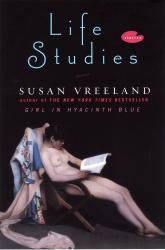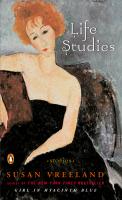






















Discussion Questions
for
Life Studies
Book Club Offer:If your book club has twelve or more members, you can schedule a twenty-minute speakerphone chat with me. I'd love to discuss these stories with readers. Please email me to set this up. Include several proposed dates and times. We'll have a good time! |
|
|
Prior to your group discussion, you might have your members pick their favorite stories from each section, Then and Now, to present to the group.
There are general and comparative questions at the end. Here are some questions to consider for each story.
THEN
Mimi with a Watering Can
1. The poet Elizabeth Barrett Browning wrote "What is art but life on a larger scale." How does this relate to Jérôme's ennui and his capacity to lift himself out of melancholy?
2. How do Mimi, Paquin, and Renoir unwittingly help to change Jérôme's frame of mind?
3. Why do the changes in Montmartre bother Jérôme? What does this show about him?
Winter of Abandon
4. Alice thinks, "There it was, life pared down to the essentials--food and work and love, and beauty too." Has she overlooked anything? Is there any rationale to the order she uses? Does her life attest this order? Would you prioritize them differently?
5. In what way is this a story of desire and betrayal?
6. Does it appear that the author is casting judgments on any of the characters. Do you? If so, what judgment and for what reason?
Cradle Song
7. How aware is Sylvie of the dynamics of her relationship with Berthe Morisot? What brings them together? What forces them apart? What is at stake for both of them?
8. Literacy is one thing that separates the two women. How does letter writing play out in both of their lives?
9. Why does Sylvie turn on Berthe and want to see her pain? What, apparently, makes her turn back?
Olympia's Look
10. Suzanne from "Olympia's Look" and "Sylvie" from "Cradle Song" are both outside of the Edouard Manet-Berthe Morisot connection. In what way are Suzanne and Sylvie struggling with similar emotions?
11. What are the range of emotions that Suzanne goes through in the course of the story?
12. Letter writing appears in this story too. Why can't Suzanne immediately see that Edouard Manet's letter to Isabelle is only "a sweet silly note," as she finally calls it, and nothing to be concerned about? What experience and realization are necessary for her to arrive at this conclusion?
The Yellow Jacket
13. Henry Ward Beecher said, "Every artist dips his brush in his own soul, and paints his own nature into his pictures." How does this relate to van Gogh painting Armand's portrait? Consider his comments as he's painting them.
14. What effect did the night café painting have on Armand? In Armand's mind, how did it relate to Jacqueline?
15. Why did the yellow jacket have the effect it had on Armand, first when he pulls it out of his father's mail sack and then when he sees the painting?
16. In what ways for both characters is this a story about yearning?
17. In a letter to his brother Theo, Vincent van Gogh wrote, "And in a picture, I want to say something comforting, as music is comforting. I want to paint men and women with that something of the eternal which the halo used to symbolize, and which we seek to convey by the actual radiance and vibration of our coloring." How does this apply to the paintings of Armand? What do you think van Gogh saw in Armand?
Of These Stones
18. Is Anatole strong or weak in character? Give examples to support your answer.
19. Paul Cézanne wrote, "The labor which brings about progress in one's own calling is sufficient compensation for a lack of comprehension on the part of fools." Do you think, in spite of this, it was difficult for Cézanne to deal with criticism? What resources did he turn to in order to bolster himself against criticism?
20. What would make a child develop the cruelty that Marc exhibits?
21. Madame Cézanne acts counter to the expectations Anatole has of her. How does this affect him?
22. In what way is this a story about loyalty?
A Flower for Ginette
23. What two repeated activities bring these two men together? How are they different?
24. Monet once said, "To me, the motif itself is an insignificant factor; what I want to reproduce is what lies between the motif and me." How does this apply to Émile?
25. Why was Émile so moved at Monet's words, "beyond an old man's powers?"
26. Claude Monet lived at Giverny and painted his garden for forty-three years. Many museums around the world have in their collections his paintings of the water garden or the flower garden at Giverny. Why do you think they are so beloved?
In the Absence of Memory
27. Giovanna searches the chest, the exhibit, the streets of Paris for some shred of connection with her father, some bit of information she can shape into an imagined memory. But what ultimately fills the void of memory for Giovanna?
28. What narrative purpose was served by the reference to the onset of World War II, and how did Giovanna personalize it?
29. What does the story say about pain?
INTERLUDE
Adventures of Bernardo and Salvatore, or The Cure: A Tale
30. Examine the relationship between Bernardo and Salvatore. Is it a good one? Why?
31. From this sample, what seem to be the literary conventions of a tale rather than a traditional short story?
32. What are the benefits of living in this time and place as opposed to contemporary times?
33. In the deepest sense, what is the cure for human ill?
NOW
The Things He Didn't Know
34. What similarity is suggested between St. Sebastian and Steve? Between the third Mary and Steve?
35. After his experience with Kathy, what can Steve write on his lists, The Things He Didn't Know, and The Things He Didn't?
36. What does Steve have in common with Bernardo and Salvatore? As Steve explores the world of art, is there anything he learns similar to what either Bernardo or Salvatore learn?
Uncommon Clay
37. What is hardest thing for the daughter to do?
38. How are the issues of dealing with memory loss expressed in the protagonist's ceramics?
39. How does Kita-oji's presence create a different kind of visit with her mother?
40. Why does she name the last pot "The Balm of Gilead?"
Respond
41. The world did not act to stop the genocide in Rwanda. How does that relate to the title of the story and to Brad's tears?
42. Whose concerns were more important?
43. What is it that wakes up Cynthia so dramatically?
44. How has the sculpting class served Cynthia?
45. If you were a marriage counselor or Cynthia's mother, what advice would you give her?
46. Speculate: Will this couple stay together and learn from each other, or is there not enough holding them together? Support your assessment.
47. Who grows?
Crayon, 1955
48. How is Jenny changed by the experiences of this summer?
49. How can death be a rich experience?
Five Hundred Words, With Sincerity and Honesty
50. What is really motivating Josie in "Five Hundred Words?" Is she foolhardy or wise? Is she smart or just a smart aleck? Why do the other students pick on her and get her in trouble?
51. Do you think going to this school is (or has been, if she has to leave) a good experience for Josie? If she has to leave, what will she take away from it?
52. Reduce this story to one word. What is it about?
Gifts
53. The title is in the plural. How many gifts are given in this story? What are the most valuable to Charles?
54. In what way in this story is art a test of love? Can art be a test of love in general, beyond this story?
55. How do you think Charles' experience of losing a grandchild influences his interaction with the mute girl on the bus?
Their Lady Tristeza
56. What are the four main opinions of the drawing? Whose opinion of the drawing is the most valid, or can this not be answered?
57. Speculate on whether Miss Talmadge will stay on in this town for another year.
58. What purpose is served by the commentary on the color of the lines of the Blue Nude?
Tableaux Vivants
59. What do Cynthia from "Respond" and Eileen from "Tableaux Vivants" have in common? What is different about their relationships with their husbands? In what way do they have the opposite problem?
60. How aware is Jeffrey of orchestrating an experiences for his mother that will be good for her beyond just being "cool?"
61. What are the ways the story explores mistaking illusion and reality?
62. How does The Cure from "The Adventures of Bernardo and Salvatore" relate to Eileen?
General Questions:
63. In what way are the stories in this collection tableaux vivants? Which was your favorite story in each section, and why? To you, who was the most appealing character?
65. How does the collection as a whole explore the ideas of acceptance and redemption?
66. Pablo Picasso said, "Everyone wants to understand art. Why not try to understand the songs of a bird?" As depicted in this collection, which painter might agree?
67. The English painter and founder of the Pre-Raphaelite Brotherhood, Holman Hunt said, "Art is love." In what sense could this be true? Are there any stories in this collection that bear this out? What are all the various kinds of love illustrated in these stories?
68. John Ruskin wrote, "Great nations write their autobiographies in three manuscripts, the book of their deeds, the book of their words and the book of their art. Not one of these books can be understood unless we read the two others, but of the three, the only trustworthy one is the last." Six of the eight stories in the "Then" section are told about French painters. Looking at the paintings by these six in the "Paintings and Passages" section of this website, what do you think they say about France?
69. In A Writer's Notebook, Somerset Maugham wrote, "Art, if it is to be reckoned as one of the great values of life, must teach men humility, tolerance, wisdom and magnanimity. The value of art is not beauty, but right action." Which stories can be associated with each of these human qualities?
susan@svreeland.com